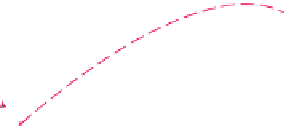Information Technology Reference
In-Depth Information
p
d
p
o
(
t
1
)
p
o
(
t
2
)
p
01
(
t
)
p
02
(
t
)
q
d
=
f
(
q
b
,
t
)
p
d
(
t
b
)
=
p
02
(
t
b
)
p
d
(
t
b
)
=
p
01
(
t
b
)
Fig. 3.5
Ball control in batting motion [10]
and a 128
128 parallel processing array. The image sensor is connected with the
parallel processing array by a special parallel signal cable. Because the visual pro-
cessing is executed in parallel in the processing array, high-speed visual processing
(moment detection, segmentation,
etc
) is achieved within 1 ms.
Each vision sensor is mounted on an active vision, which has 2 DOF (the pan
and tilt). By integrating the image information with the joint angle information, the
3D position is calculated precisely. The information acquired by the vision system
is sent to the manipulator at the rate of 1 kHz.
×
3.2.3
Batting Algorithm
The desired trajectory of the manipulator is generated by the following three steps:
1. measure the position of the target
p
o
by stereo vision, and estimate the position
of the target at the hitting time
t
=
t
b
;
2. compute the position
p
(
t
b
) and orientation
φ
(
t
b
) of the end-effector at the hitting
time
t
=
t
b
;
3. generate the desired trajectory
q
d
satisfying the boundary condition.
In every cycle time, the steps 1 and 2 are repeated from the first time the vision
recognizes the target until the time the manipulator swings (
t
= 0), and the steps
1, 2 and 3 are repeated until the hitting time (
t
=
t
b
). This means that the hitting
point is estimated before impact explicitly, and the batting task is accomplished by
modifying this point based on visual feedback. The detailed processes are explained
in the following.
Step 1
. First, the 3D visual information is calculated by means of the stereo ac-
tive vision. By image-based visual servoing, the active vision executes 3D tracking






























































Search WWH ::

Custom Search